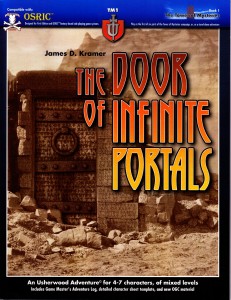The lone sentinel stands 7 ft-tall, is some 3 ft-thick, and 6 ft-wide. Its existence is relegated to the purview of sages, story tellers, shamans, and imaginative bards. Reasons for the Door’s appearance throughout history is unknown, and tales of its creation (as well as its true purpose) are equally mysterious and varied…
An evocative central premise is somewhat spoiled by a funhouse-like amount of arbitrary content.
The hook for this module is a doorway that appears out of nowhere. Through it lies the Hall of Keys, and from there portals to many different world. This concept has been seen several times before, notably in TSR’s Q1. The door proper, as well as the Hall of Keyes are richly described. Various options are provided for the origin of the door and how it appears. These small paragraphs are magnificently done. Imagine a snowy mountain pass and the characters slogging through hip-deep drifts. There on a crest is the door, and no snow falls within 30 feet of it … or that you are hacking your way through thick jungle vegetation when suddenly you burst you in to a clearing with the door in the center and all of the plant and animal life dead within 30 feet of it. Now imagine they were done by someone with talent instead of a hack RPG reviewer. They are concise and evocative and really allow you paint a picture in your mind of what the environment is like. Then … things start to break down a bit. The description of the door proper takes almost half a page with another half page devoted to opening it. Those half pages build up a perfect picture of a Door of Infinite Portals; the thing is described beautifully and in nearly every way the characters could investigate it, it just gets a little long.
The door opens up in to the Hall of Keys. Like the door it is described in wonderful detail over about six pages. Some notable features of the Hall are that it is: lined everywhere with keys on hooks, has some portals in it, has a wooden throne on one end, and is covered with the bones and debris of thousands of creatures. Nice. Just like the door and the background the entire place is wonderfully described and really lets the DM imagine what the place is like, which I find then kickstarts my own imagination and lets me run with things. Almost an entire page is given over to the description of the keys while another four pages is given over to the description of what can be found searching the debris. These are magic items done right. Each one gets two or three paragraphs describing it and it’s powers with making up the bulk of the four pages that describe the boneyard and refuse inside the hall. They are very well done indeed and will be items that the party remember.
It is at this point that the module begins to break down a bit and loose focus. The idea is that the party is stuck here and must collect keys from the various portals in order to unlock the way back to their own homes. Four such examples are given for the DM: The Tower of Mysteries, Planet of the Orcs, a graveyard, and The Brigand Caves, each of which contains one of the keys the party needs. The transition in the modules layout between the Hall and the portal worlds is lacking a bit and not up to the usual very high standards of layout found in Usherwood products. The little mini-worlds are quite gimmicky and feel a bit like a twilight zone episode. In the graveyard all of the land can fall away in to the void at one point, except for the walls which kind of hang there, in space. In the Planet of the Orcs there are some prisoners who have been captured by orcs and rescued by other groups time and time again. This is a neat bit of theater for raising the tension since the prisoners can tell the party about others that have come before, only to never return or die. The Tower and graveyard in particular have a nice load of loot, with the Towers being richly detailed. The tower is full of traps and the graveyard is CRAWLING with undead, however the brigand caves may be the hardest challenge. Players may underestimate human brigand opponents, only to find themselves facing 10th and 12th level fighters. The module ends with the usual assortment from Usherwood: excellent GM adventure logs, about 20 very good pre-gen characters (nice to see Gordo’s hit 4th level), a half dozen or so new monster types, an appendix of detailed background for those that want it, and the richly detailed maps that I’ve come to expect from Usherwood. Both the layout and the content tends to suffer a bit in these sections. The content is short and feels more like individual twilight zone episodes (the mists of Castle Amber …) and the layout … well, something feels off about it.
If I were to use this I would probably steal the Door & Hall and make it the center of the campaign. Maybe start the characters out on an adventure or two, introduce the Door, and then have them adventure through it on a variety of quests in order to collect the keys. One of them could see the prisoners dropped in in order to enforce the idea of escape being a hopeless undertaking, and then finally returning them with their world significantly changed (Midnight, anyone?). Thus as a campaign idea the Door is an excellent product, however as a stand-alone and self-contained product it’s lacking.
This is available on DriveThru.
https://www.drivethrurpg.com/product/79075/The-Door-of-Infinite-Portals?affiliate_id=1892600

